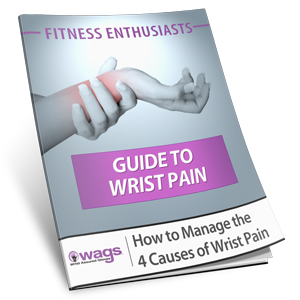With spring in bloom, there are a lot of opportunity to move, get yard work done, bicycle your neighborhood, work out, and more. It feels good, but look out for tendinitis — it can sneak up on you when you are overzealous about getting it all in! WAGs is here to help. Read on to learn more, and get the wrist support you need from our fitness gloves.
Causes of Tendinitis
First, let’s look at what causes tendinitis. This way we might avoid it!
- Repetitive movements or series of movements (doing too many sun salutations or raking non-stop)
- Movements with high force on the muscle or tendon (lifting weights that are too heavy or garden pots)
- Excessive stretching of muscles (easy to do in hot yoga class)
- Fast, rapid, or jerky movements (especially when not warmed up)
- Reduced muscle strength, which increases stress on tendons
- Not enough rest after injury (resuming exercise before muscles and tendons are fully healed)
Your symptoms can appear suddenly, such as a rapid movement pulls a muscle, or they can develop over a period of time when you overuse the same muscle group. But once your symptoms appear, if you address them instead of ignoring them, you can heal more quickly
Symptoms of Tendinitis
Tendinitis typically begins as nagging pain at the site of the tendon and the surrounding muscles. The pain can sharp or dull, aching or burning, and it may radiate up or down the limb.
Tendinitis pain can be aggravated by full range of movement and/or resistance applied (i.e. weights, carrying a heavy object). The pain can be specific to certain positions and actions, such as difficulty gripping a pot with the arm straight (tennis elbow) or turning a key (thumb tendinitis).
Other signs of tendinitis include inflammation and swelling at the tendon, joint, or surrounding area, as well as potential redness and warmth occurs at the site of pain. The pain can be accompanied by stiffness too. If redness, warmth, and inflammation occur, this is a sign that you need to treatment.
Healing Tendinitis
If your tendinitis pain is mild, self management is possible. If it’s moderate to severe or constant, seek the advice of medical professionals. Remember the acronym RICE: rest, ice, compression, and elevation. It’s always good to start with this!
Rest
Complete rest of the sore tendon will allow the healing process to begin. Generally two or more weeks is needed. Continuing the repetitive or forceful movements that caused your tendinitis will only aggravate and worsen symptoms.
Modify Activities
If it’s not possible to completely rest, then try to alter any activity that causes pain or puts stress on the tendon. Notice what movements causes or increases pain, and then avoid doing this movement. Using correct body positioning and body mechanics will reduce stress on your muscles and tendons.
Reduce Pain & Swelling
Elevate the affected limb and wrap it in cold packs for 10 to 20 minutes about two to four times a day. Try to keep the area elevated above your heart to help minimize swelling. A bag of frozen peas works well to ice small areas like the thumb or wrist.
An ice massage directly on the painful area is also very effective. You can use an ice cube wrapped in wash cloth, or you can freeze water in a star foam or Dixie cup for smaller joints and then peel away the paper. Rub the ice directly over and around the area for two to four minutes until numb, and repeat two to four times a day. Do not leave the ice in one place on the skin.
Compression Wraps
Elastic wraps (ace bandages), stretchable joint supports, compression gloves, wrist braces for tendinitis, and soft splints can reduce pain and swelling by providing even pressure around the affected tendons and muscles. They also serve as a visual reminder to take it easy on this area.
Make sure that any elastic bandages you use are not wrapped too tight. This can cause more swelling above/below the affected area. Signs that the bandage is too tight include numbness, tingling, increased pain, coolness, or swelling in the area below the bandage.
Our Wrist Assured Gloves (WAGs) provides tendinitis wrist support and are good to use if you have mild tendinitis of the wrist or basal thumb joint. Many customers prefer the Ultra or the Fusion style with the wrist wrap because both styles add extra support and compression to the tendons.
Therapy for Tendinitis
Seek the advice of a medical practitioner if your tendinitis persists. Persistent pain means you likely need the treatment of a skilled physical or occupational therapist to control your symptoms. An evaluation of your body mechanics and ergonomics can be really helpful.
The course of therapy to improve tendinitis may include:
- Splinting the area for complete immobilization and rest
- Semi-rigid, soft supports or kineseotaping
- Posture analysis and instruction in proper body mechanics
- Ergonomic training, work station modification, or use of adaptive aids
- Modalities such as ultrasound or electrical stimulation
- Soft tissue mobilization / Graston Technique (GT)
- Progressive strengthening and endurance conditioning once symptoms have subsided
- Topical creams for pain relief and swelling
- Anti-inflammatory medication and steroid injections (as prescribed by MD)
How to Prevent Tendinitis
Tendinitis can sneak up on you and wreak havoc! Make sure you don’t have to sit out with an injury by always warming up first. Gentle movements and stretches before exercising or yard work are a good idea. When doing yard work, make sure that you don’t do the same movements repeatedly, which is common in activities like raking. Pace yourself if you are starting a new workout until you build up your strength and endurance. Remember to mix it up so you’re not using the same muscle groups repeatedly in the same motions. Doing the same thing over and over makes you prone to tendinitis — keep in mind, variety IS the spice of life!
Most importantly, you should listen to your body’s warning signals and don’t ignore pain.
If you want some wrist support, check out our fitness gloves! WAGs are available in multiple styles to meet your needs no matter what activities you prefer. From a versatile style made for cross training to ultra-supportive yoga gloves with a secure wrist wrap, you can find the right ergonomic gloves for you at WAGs. Explore our site to learn more about how our therapeutic design can help you, and place your order today!




